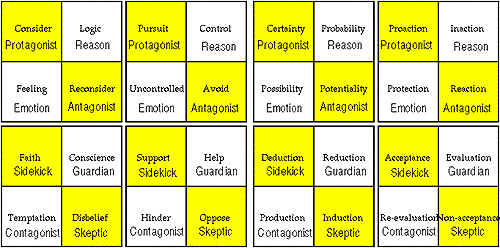In each quad of Elements, we find not only Dynamic (diagonal) Pairs, but horizontal and vertical pairs as well. Horizontal Elements are called Companion Pairs, and vertical Elements are Dependent Pairs. Each kind of pair describes a different kind of relationship between the Elements, and therefore between the characters that represent them.
In addition to the three types of pairs, we can look at each Element as a separate component and compare it to the overall nature of the quad itself. This Component approach describes the difference between any given Element and the family of Elements in which it resides (quad). Therefore, the degree of individuality the characters represent within the “group” can be explored.


Dynamic Pairs describe Elements with the greatest opposition to one another. Whenever two opposing forces come together they will create either a positive or negative relationship. They can form a synthesis and create something greater than the sum of the parts or they can simply tear away at each other until nothing is left (destructive). Within a quad, one of the Dynamic Pairs will indicate a positive relationship, the other a negative one. Which is which depends upon other story dynamics.
Companion Pairs contain the Elements that are most compatible. However, just being compatible does not preclude a negative relationship. In a positive Companion Pair, characters will proceed along their own paths, side by side. What one does not need they will offer to the other (positive impact). In a negative Companion Pair, one character may use up what the other needs. They are not against each other as in a negative Dynamic Pair, but still manage to interfere with each other’s efforts (negative impact).
Dependent Pairs are most complementary. In a positive sense, each character provides strengths to compensate for the other’s weaknesses (cooperation). Together they make a powerful team. In its negative incarnation, the Dependent Pair Relationship has each character requiring the other in order to proceed (codependency).
Components describe the nature of the Elements in relationship to the overall quad. On the one hand, the individual characters in a quad can be a group that works together (interdependency). The group is seen to be greater than the individual characters that comprise it, at the risk of overwhelming the individuality of its members. This is contrasted by identifying the disparate nature of each character in the quad (independency). Seen this way, the characters are noted for their distinguishing characteristics at the risk of losing sight of shared interests.
Dynamic Relationships are the most familiar to writers, simply because they generate the most obvious kind of conflict. Companion and Dependent Pairs are used all the time without fanfare, as there has previously been no terminology to describe them. Components are useful to writers because they allow characters in groups to be evaluated in and out of context.
By constructing characters with thought and foresight, an author can use the position of Elements in the Chess Set to forge relationships that are Dynamic in one dimension while being Companion and Dependent in others. Characters created with Dramatica can represent both the structural Elements of the Story Mind’s problem solving techniques and the dynamic interchange between those techniques.
From the Dramatica Theory Book





